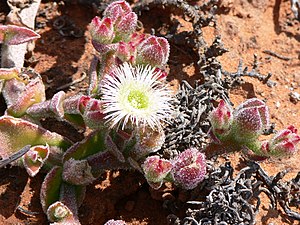Mesembryanthemum
| Mesembryanthemum | ||||||||||||
|---|---|---|---|---|---|---|---|---|---|---|---|---|

Icewort ( Mesembryanthemum crystallinum ) |
||||||||||||
| Systematics | ||||||||||||
|
||||||||||||
| Scientific name | ||||||||||||
| Mesembryanthemum | ||||||||||||
| L. |
Mesembryanthemum is a genus of plants fromthe afternoon flower family (Aizoaceae).
description
The species of the genus Mesembryanthemum are lying, prostrate or upright herbaceous plants with fibrous roots . They are usually one year old and sometimes become very large. The internodes are herbaceous, twisting, angular or winged. Their flat, cylindrical to slightly groove-shaped leaves are almost truncated or almost round. They sit cross-opposite and are briefly fused at the base. When the inflorescence is formed or during flowering, they become alternate. Flat leaves do not contain any, while cylindrical leaves contain enlarged, central water-storing cells. The large to flattened bladder cells are mesomorphic.
The zymous inflorescence reaches a diameter of 10 to 60 millimeters. The five sepals are fused with the pale pink, yellow or white petals to form a short tube. However, sometimes they are also free. The petals are thread-like or narrowly lanceolate and only rarely strongly receded. Thread-like staminodes may be present or absent. The nectaries are narrow, shell-shaped or tubular.
The flap wings of the five-way capsule fruits are bent upwards or downwards over the flaps and grown together in pairs. The capsule fruits contain black, brown, yellow or whitish, D-shaped or triangular seeds 0.5 to 1 millimeter in length.
Systematics and distribution
The genus Mesembryanthemum is found in southwest Angola , southwest Australia , the Azores , the Canary Islands , the Cape Verde Islands , Iraq , Iran , the Mediterranean region , Namibia , northern Africa, Palestine , St. Helena , in the Turkey , distributed in California and the South African provinces of Eastern Cape , Free State , Northern Cape and Western Cape . The plants often grow on salty soils, mostly in disturbed places and along roadsides.
The genus Mesembryanthemum includes the following subgenera and species:
- Subgenus Cryophytum
(NEBr.) Bittrich
- Mesembryanthemum barklyi N.E.Br.
- Ice herb ( Mesembryanthemum crystallinum L. ): It is originally found in Spain, France, Italy, Croatia, the Azores, Madeira, the Canaries, Morocco, Algeria, Tunisia, Libya, Egypt, the Sinai Peninsula, Israel, Mauritania, on St. Helena, in southwestern Angola, Namibia and South Africa. It is a neophyte in North and South America, Australia, and Portugal. In Greece the originality is uncertain.
- Mesembryanthemum gariusanum Dinter
- Mesembryanthemum guerichianum Pax : It is originally found in Namibia and South Africa and is a neophyte in Australia.
- Mesembryanthemum pellitum Friedrich
- Mesembryanthemum subgenus
- Mesembryanthemum aitonis Jacq. : It occurs in South Africa.
- Mesembryanthemum excavatum (L.Bolus) L.Bolus
- Mesembryanthemum inachabense Engl.
- Mesembryanthemum longistylum DC.
- Mesembryanthemum subtruncatum L. Bolus
- Knot-flowered ice plant ( Mesembryanthemum nodiflorum L. ): It is native to Portugal, Spain, France, Italy, Greece, Macaronesia, the Arabian Peninsula, Western Asia, Namibia and South Africa. It is a neophyte in North America, Argentina, Chile and Australia.
- Mesembryanthemum stenandrum (L.Bolus) L.Bolus
- Subgenus Opophytum (NEBr.) Bittrich
- Mesembryanthemum cryptanthum Hook. f. : It occurs in Morocco, Algeria, Libya, Egypt, on the Sinai Peninsula, in Israel, Jordan, Syria, in southwestern Angola, in Namibia and in South Africa.
- Mesembryanthemum eurystigmatum Gerbaulet
- Mesembryanthemum fastigiatum Thunb.
- Mesembryanthemum hypertrophicum Dinter
Botanical history
The name Mesembryanthemum (midday flowers) was coined by Jakob Breyne in his work Prodromus fasciculi rariorum plantarum in 1689 and used by Johann Jacob Dillen in 1732 . Carl von Linné took it over in 1753 in his work Species Plantarum . There are two interpretations of the etymology of the botanical name . Either it is derived from the Greek words “mesembria” for noon and “anthemon” for blossom or from “mes” for middle and “embryo” for ovule .
For a long time the genus was a collective genus for several hundred species. Nicholas Edward Brown recognized a good morphological characteristic in the structure of the fruit in the 1920s and began to subdivide the large genus into small genera.
proof
literature
- Gideon Smith et al. a. (Ed.): Mesembs of the World: Illustrated Guide to a Remarkable Succulent Group . Briza Publications, 1998, ISBN 1-875093-13-3 , pp. 40 .
- Heidrun EK Hartmann (Ed.): Illustrated Handbook of Succulent Plants: Aizoaceae FZ . Springer Verlag, Berlin / Heidelberg / New York 2001, ISBN 3-540-41723-0 , pp. 143-167 .
Individual evidence
- ↑ Heidrun EK Hartmann (Ed.): Illustrated Handbook of Succulent Plants: Aizoaceae FZ . Springer Verlag, Berlin / Heidelberg / New York 2001, ISBN 3-540-41723-0 , pp. 143-167 .
- ↑ a b c d e f g h Mesembryanthemum in the Germplasm Resources Information Network (GRIN), USDA , ARS , National Genetic Resources Program. National Germplasm Resources Laboratory, Beltsville, Maryland. Retrieved October 22, 2018.
further reading
- Cornelia Klak, Peter V. Bruyns: A new infrageneric classification for Mesembryanthemum (Aizoaceae: Mesembryanthemoideae) . In Bothalia . Volume 43, number 2, 2013, pp. 197-206 ( PDF ).
- Cornelia Klak, Pavel Hanáček, Peter V. Bruyns: Phylogeny and taxonomy for Mesembryanthemum subg. Volkeranthus (Aizoaceae-Mesembryanthemoideae) . In: South African Journal of Botany . Volume 95, 2014, pp. 112–122 ( doi: 10.1016 / j.sajb.2014.08.006 )